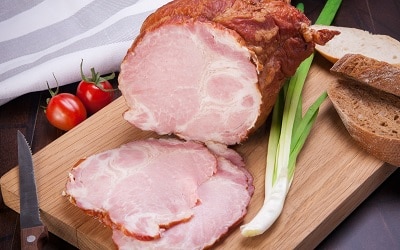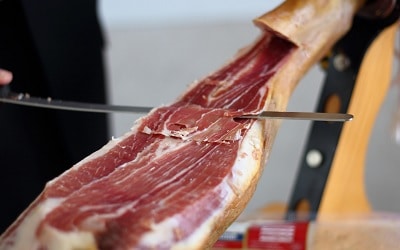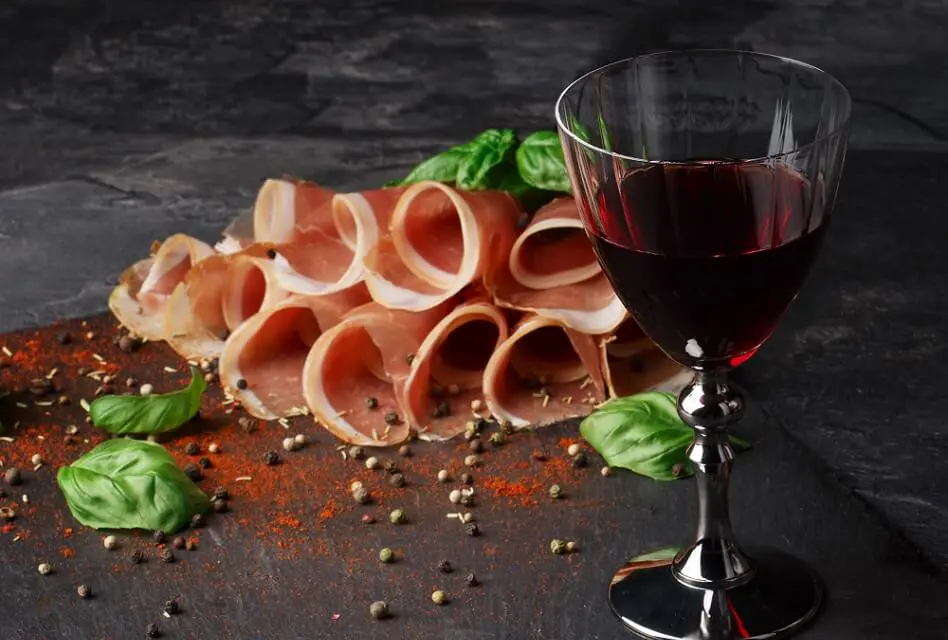Throughout history, people tried to prevent meat (and fish) from spoiling and make it durable. For this purpose, they created many different techniques. Today, refrigerators can do this job. But as the traditional methods not only make meat durable but also give it exceptional flavors, many producers still use them. Whether ham is fresh or cured, it is delicious with wine – given that you pick the right one. But which are the best ham and wine pairings?
The best wine to pair with ham is either a dry, acidic white wine or a medium-bodied red wine. The wine should not be too bold, so it does not overpower the ham’s flavors. Wines with subtle sweet notes can be great pairings as well.
Of course, the best wine pairing for ham depends on both the ham’s and the wine’s flavor profiles. So it makes a big difference if your ham is a honey-glazed roast or a Spanish Iberico ham. This article will discuss the best ham with wine combinations in detail:
- Ham with Sweet Glazes and Wine
- Ham with Savory and Spicy Glazes and Wine
- Jamón Serrano and Wine
- Jamón Ibérico and Wine
- Prosciutto and Wine
- Black Forest Ham and Wine
- Westphalian Ham and Wine
Before we get into the details, let us discuss what exactly ham is.
WHAT IS HAM?
Ham is pork. More specifically, it is the meat from the hind leg of a domestic pig. Typically, ham is salty, has a fleshy density, and is relatively low in fat compared to other pork cuts. Often, it also has a subtle sweetness that creates an exciting counterpart to its saltiness.
Ham comes in many variations, and depending on the preparation, its flavors can vary significantly. Fresh ham is great for immediate preparation and consumption. Especially for holidays like Christmas, ham roasts are very popular in Europe and the United States.
But you can also find many cured ham specialties from different parts of the world. They are either salted, smoked, or wet-cured. These preparations preserve the ham so that it can last for months or even years.
The most noteworthy cured hams are:
- Spanish Jamón, including Serrano and Ibérico
- Italian Prosciutto (also known as Parma ham)
- Smoked Ham from Germany, for example, Black Forest ham or Westphalian ham
SELECTING THE RIGHT HAM AND WINE PAIRING
The most basic rule for pairing meat and wine is straightforward: Red wine goes with red meat, and white wine goes with white meat. For wine and ham, this rule is a bit too simple. The reason is that ham is less fatty than steaks, burgers, or other red meat chops. Thus, both red wines and white wines can be good pairings for ham.
As a general rule, you should avoid wines that are too bold. Full-bodied wines can easily overpower the ham flavors. A light- to medium-bodied wine is typically the better choice.
It makes perfect sense to pick a wine that comes from the same region as the ham. So when looking for pairings for an Italian ham, you should focus on Italian wines first. Do not be too rigid about this rule, though. Sometimes crossing a border and searching in a neighboring region can result in a great match, too.
Let us discuss some ham specialties and the best wines to match them to get a better idea about the right pairing.
GLAZED BAKED HAM AND WINE
Baked ham is a traditional favorite around Christmas and Thanksgiving. When they come out of the oven, these roasts deliciously combine the salty meat’s richness with the glaze’s spicy and sweet aromas. Depending on the glaze you choose, you can create very versatile flavor experiences.
Wine and Ham With Sweet Glazes
The best wine for honey-baked ham is a fruity red wine. Make sure it is not too bold, though. Pinot Noir is a great pick, especially when it comes from a New World wine country. Its fruity bouquets combine perfectly with the sweet notes of the glaze without overpowering them.
If you prefer white wine, try an Italian Pinot Grigio. These dry, light-bodied styles typically have notes of citrus and green fruits. Thus, they create interesting sweet and bitter combinations with the ham.
The same goes for dry Riesling from Germany.

Ham Roast
Rebholz Von Rotliegenden Riesling Trocken 2020
- type: white, still, Vintage
- origin: Pfalz, Germany
- varietal: Riesling
- alcohol: 12.0%
Burklin-Wolf Pfalz Estate Riesling Trocken 2020
- type: white, still, Vintage
- origin: Pfalz, Germany
- varietal: Riesling
- alcohol: 12.0%
Von Winning Deidesheimer Paradiesgarten Riesling Erste Lage Trocken 2020
- type: white, still, Vintage
- origin: Pfalz, Germany
- varietal: Riesling
- alcohol: 12.0%
Wine lovers with a sweet tooth might also enjoy a sweet and sweet pairing. French Gewürztraminer from the Alsace region, for instance, is an excellent wine for this purpose. It is medium-bodied with subtle spicy and bitter notes.
- type: white, still, Vintage
- origin: Alsace, France
- varietal: Gewürztraminer
- alcohol: 14.0%
Zind-Humbrecht Gewürztraminer 2019
- type: white, still, Vintage
- origin: Alsace, France
- varietal: Gewürztraminer
- alcohol: 14.0%
Albert Boxler Gewürztraminer Reserve 2018
- type: white, still, Vintage
- origin: Alsace, France
- varietal: Gewürztraminer
- alcohol: 14.0%
The same wines also work for other sweet glazes, such as brown sugar or pineapple recipes.
Wine and Ham With Savory and Spicy Glazes
Hams with spicy glazes pair well with Pinot Noir as well. No matter if you prepare your glaze with mustard, cayenne, or chili, this light red is a great choice. In this case, you should go for Old World styles, though. They are typically higher in acidity, so they can better handle a savory preparation. In addition to intense flavors of red and black fruits, they offer wooden and earthy notes that match deliciously with spicy glazes.
Joseph Drouhin Laforet Pinot Noir 2019
- type: red, still, Vintage
- origin: France, Burgundy
- varietal: Pinot Noir
- alcohol: 12.5%
Remoissenet Beaune Teurons Premier Cru 2019
- type: red, still, Vintage
- origin: France, Burgundy
- varietal: Pinot Noir
- alcohol: 14.0%
Domaine Comte Georges de Vogue Bonnes-Mares Grand Cru 2018
- type: red, still, Vintage
- origin: France, Burgundy
- varietal: Pinot Noir
- alcohol: 13.0%
Gamay wines have very similar characteristics, so feel free to try them instead.
Barolo might be another good choice for red wine lovers. It has similar aromas as Pinot Noir and Gamay. But as it is significantly bolder and more tannic, it is only an option for very savory ham preparations. Try one of these:
- type: red, still, Vintage
- origin: Italy, Piedmont
- varietal: Nebbiolo
- alcohol: 14.5%
Damilano Barolo Lecinquevigne 2015
- type: red, still, Vintage
- origin: Italy, Piedmont
- varietal: Nebbiolo
- alcohol: 14.5%
- type: red, still, Vintage
- origin: Italy, Piedmont
- varietal: Nebbiolo
- alcohol: 14.0%
Again, there are other great matches for fans of sweet wine. Especially sweet sparkling wines create interesting pairings with hot ham seasonings because the bubbles reduce the spices’ heat on the palate. Go for Moscato d’Asti, Asti Spumante, or Lambrusco. All of these sweet sparklers come from Italy.
- type: white, semi-sparkling, Vintage
- origin: Piedmont, Italy
- varietal: Muscat
- alcohol: 6.0%
Vietti Moscato d'Asti Cascinetta 2020
- type: white, semi-sparkling, Vintage
- origin: Piedmont, Italy
- varietal: Muscat
- alcohol: 5.5%
- type: white, semi-sparkling, Vintage
- origin: Piedmont, Italy
- varietal: Muscat
- alcohol: 6.0%
- type: white, sparkling
- origin: Piedmont, Italy
- varietal: Muscat
- alcohol: 5.0%
- type: white, sparkling
- origin: Piedmont, Italy
- varietal: Muscat
- alcohol: 7.5%
- type: white, sparkling
- origin: Piedmont, Italy
- varietal: Muscat
- alcohol: 7.5%
WHICH WINES TO PAIR WITH SPANISH JAMÓN
Jamón (English: ham) is an indispensable element of Spanish cuisine. You can find it in every tapas bar, every restaurant, and even in most private kitchens throughout the country. Typically, it is served as a single dish in a tapas menu or as a finger food snack with bread and cheese.
Just like winemaking, producing high-quality jamón is more an art than a craft. And over the centuries, the Spanish have developed different ways to make numerous excellent types of ham.
Jamón Serrano and Wine Pairings
One of the most popular types is Jamón Serrano. Its name derives from the Spanish word “sierra” (English: mountains) and indicates that it historically was made in mountainous regions with moderate climates.
Jamón Serrano undergoes a meticulous and traditional production process that significantly contributes to its distinctive flavor and texture. Initially, the ham is generously covered with sea salt, which acts as a natural preservative, and placed in a highly humid environment for several days. This step is crucial as it allows the salt to penetrate the meat, enhancing its flavor and ensuring its preservation.
Following this salting phase, the ham is transferred to a well-ventilated area where it air-dries for an average of 12 months. During this period, the ham is exposed to varying environmental conditions that mimic the changing seasons, allowing it to mature gradually. This natural curing process is essential for developing the ham’s complex flavors and rich aromas.
As the ham ages, it loses over one-third of its original weight, concentrating its flavors and resulting in a product with intense aromas and a delicate, savory taste. The careful balance of time, temperature, and humidity during the curing process is what gives Jamón Serrano its unique characteristics, making it a prized delicacy that pairs exceptionally well with a variety of wines.
Pair Serrano with young, low-tannin red wines such as French Beaujolais. The formerly mentioned Pinot Noir is a good match as well. Again, go for a wine from the Old World, such as France.

Jamón Serrano
Duboeuf Julienas Chateau des Capitans 2020
- type: red, still, Vintage
- origin: France, Burgundy
- varietal: Gamay
- alcohol: 13.0%
- type: red, still, Vintage
- origin: France, Burgundy
- varietal: Gamay
- alcohol: 13.0%
Jean-Paul et Charly Thevenet Morgon Vieilles Vignes 2021
- type: red, still, Vintage
- origin: France, Burgundy
- varietal: Gamay
- alcohol: 12.5%
Serrano is significantly less fatty than most other types of ham. Thus, it also matches very well with white wines, particularly those from Spain. For example, consider enjoying it with an Albariño. This dry white is light-bodied and low in tannins. But because of its crisp acidity, it can easily cut through the meat. Verdejo wine from the Rueda DO is an excellent option with similar characteristics, too.
Shaya Habis Old Vines Verdejo 2018
- type: white, still, Vintage
- origin: Spain, Rueda
- varietal: Verdejo
- alcohol: 13.5%
Marques de Caceres Verdejo 2020
- type: white, still, Vintage
- origin: Spain, Rueda
- varietal: Verdejo
- alcohol: 13.5%
Bodegas Vatan Nisia Verdejo 2018
- type: white, still, Vintage
- origin: Spain, Rueda
- varietal: Verdejo
- alcohol: 13.5%
Jamón Ibérico and Wine Pairings
Another exquisite ham delicacy from Spain is Jamón Ibérico, or Iberian ham, renowned for its rich flavor and luxurious texture. This ham is crafted from the black Iberian pig, a traditional breed native to Spain and Portugal. Unlike pigs raised in modern factory farming, these animals benefit from species-appropriate husbandry, allowing them to roam freely in expansive enclosures that include pastures and oak groves. This natural environment is crucial for their well-being and contributes significantly to the quality of the ham.
The pigs’ diet is carefully curated to include maize, barley, chestnuts, acorns, and olives, which not only ensures their health but also imparts a distinctive nutty flavor to the ham. The combination of this diet and the pigs’ ability to accumulate intramuscular fat results in Jamón Ibérico’s characteristic fine marbling, which is a hallmark of its superior quality.
The curing process of Jamón Ibérico is an art in itself, involving multiple phases of salting and air drying. This meticulous process can take anywhere from two to four years, depending on the producer and the desired quality of the final product. During this time, the ham undergoes a transformation, developing complex flavors and a melt-in-your-mouth texture that is highly sought after by connoisseurs. The extended curing period allows the flavors to deepen and mature, resulting in a delicacy that is celebrated worldwide for its unparalleled taste and texture.
When selecting a wine to pair with Jamón Ibérico, pick a bold red. Wines from the Rioja DO or the Ribeira del Duero DO are great choices.
La Rioja Alta Gran Reserva 904 Tinto 2011
- type: red, still, Vintage
- origin: Spain, Rioja
- varietal: Tempranillo
- alcohol: 13.5%
La Rioja Alta Vina Ardanza Reserva 2012
- type: red, still, Vintage
- origin: Spain, Rioja
- varietal: Tempranillo
- alcohol: 14.5%
Torre de Ona by La Rioja Alta Reserva Finca Martelo 2014
- type: red, still, Vintage
- origin: Spain, Rioja
- varietal: Mazuelo, Tempranillo
- alcohol: 14.5%
Others made from Tempranillo grapes might work as well.
WHICH WINES TO PAIR WITH PROSCIUTTO
Prosciutto di Parma is a celebrated type of raw, cured ham originating from the Italian city of Parma, with a rich history that dates back thousands of years to the Roman Empire. Over the centuries, Italians have refined the production processes, yet the fundamental steps remain true to the ancient methods, preserving the authenticity and tradition of this renowned delicacy.
This exquisite ham is crafted from the legs of the European white pig, known for its quality meat. The process begins with salting, where the ham is generously coated with sea salt. It then rests for several weeks, allowing the salt to draw out moisture from the meat, which concentrates its flavors and acts as a natural preservative. This crucial step ensures the ham’s longevity and enhances its taste profile.
After the salting phase, the ham is meticulously washed to remove excess salt and is then seasoned with a blend of spices and herbs. This seasoning can include black pepper, garlic, rosemary, and other aromatic herbs, which infuse the meat with additional layers of flavor. The ham is then left to dry-age for up to three years in carefully controlled conditions, where it develops its signature taste and texture.
When ready for consumption, Prosciutto di Parma is rich in flavor, offering a harmonious blend of distinct salty and subtly sweet notes. The extended aging process allows the flavors to mature, resulting in a delicacy that is both complex and refined. The seasoning adds depth, with hints of herbs and spices that complement the natural taste of the ham. This combination of tradition, quality ingredients, and meticulous craftsmanship makes Prosciutto di Parma a prized addition to any culinary experience, whether enjoyed on its own or paired with a fine wine.
Italians traditionally serve it in thin slices on a charcuterie board together with cheese, figs, melon, or bread, making for a delightful food pairing. But it also makes a great ingredient in main courses, for instance, to wrap pork chops or as a pizza topping.

Pizza Prosciutto
La Magia Brunello di Montalcino 2016
- type: red, still, Vintage
- origin: Tuscany, Italy
- varietal: Sangiovese
- alcohol: 15.0%
Val di Suga Brunello di Montalcino 2016
- type: red, still, Vintage
- origin: Tuscany, Italy
- varietal: Sangiovese
- alcohol: 14.0%
Col d'Orcia Brunello di Montalcino 2015
- type: red, still, Vintage
- origin: Tuscany, Italy
- varietal: Sangiovese
- alcohol: 14.5%
When served as antipasti, you can pair Prosciutto with dry white wines such as Pinot Gris or Friulano. Sparkling whites like Prosecco are great matches, too.
- type: white, sparkling
- origin: Veneto, Italy
- varietal: Glera
- alcohol: 11.0%
- type: white, sparkling
- origin: Veneto, Italy
- varietal: Glera
- alcohol: 11.0%
Fantinel One and Only Prosecco Brut 2017
- type: white, sparkling, Vintage
- origin: Friuli-Venezia Giulia, Italy
- varietal: Glera
- alcohol: 12.0%
WHICH WINES TO PAIR WITH GERMAN HAM
Germany has a long tradition of producing cured meats. And you can find very different types in numerous regions. Among them are two types that gourmets all over Europe love: Black Forest ham and Westphalian Ham.
Black Forest Ham and Wine Pairings
Black Forest ham, known as Schwarzwälder Schinken in German, is a traditional delicacy from the Black Forest region in Southwest Germany. This ham holds the distinction of being the most popular type of ham in Europe and is protected by European laws, ensuring its authenticity and quality.
Crafted from the legs of domestic pigs, Black Forest ham undergoes a meticulous multi-step curing process that imparts its distinctive flavors. The journey begins with salting and seasoning, where each producer follows a unique recipe, often a closely guarded family secret passed down through generations. Despite the variations, common ingredients include salt, pepper, garlic, cilantro, and juniper berries. These spices are carefully applied, and the hams are placed in brining containers for several weeks, allowing the flavors to penetrate deeply into the meat.
Following the brining phase, the hams are transferred to special smoking towers, where they are smoked over a blend of fir and juniper wood. This smoking process lasts several weeks and is crucial for developing the ham’s characteristic smoky aroma and flavor. The choice of wood and the duration of smoking are carefully controlled to achieve the perfect balance of smokiness without overpowering the other flavors.
The final step in the production of Black Forest ham is the ripening phase, where the hams are left to mature for up to three months in air-conditioned rooms. During this time, the flavors continue to develop and meld, resulting in a ham that is rich in salty, spicy, herbal, and smoky aromas. Unlike Prosciutto, Black Forest ham does not possess sweet notes, offering a more robust and savory profile.
In Germany, Black Forest ham is traditionally enjoyed with butter on a slice of rustic black bread, highlighting its bold flavors. It is also a versatile ingredient in various culinary applications, enhancing pasta dishes, quiches, and serving as a flavorful wrap for vegetables such as beans or asparagus. The combination of traditional methods, quality ingredients, and regional expertise makes Black Forest ham a cherished delicacy that continues to delight palates across Europe and beyond.
To match its fantastic taste, you should pick an elegant, dry wine. For friends of white wine, a dry German Riesling is a great option (see examples in the glazed ham section).
Rebholz Von Rotliegenden Riesling Trocken 2020
- type: white, still, Vintage
- origin: Pfalz, Germany
- varietal: Riesling
- alcohol: 12.0%
Burklin-Wolf Pfalz Estate Riesling Trocken 2020
- type: white, still, Vintage
- origin: Pfalz, Germany
- varietal: Riesling
- alcohol: 12.0%
Von Winning Deidesheimer Paradiesgarten Riesling Erste Lage Trocken 2020
- type: white, still, Vintage
- origin: Pfalz, Germany
- varietal: Riesling
- alcohol: 12.0%
Alternatively, try a Viognier from the Côtes du Rhône region in France. This region also has some matching wines for red wine lovers. Especially if your ham has a layer of fat, the Syrah wines from the area will pair fantastically with it.
For those who like to experiment, orange wine is a secret tip. It has a significant level of tannins and an at least a medium body. Its spicy and nutty notes match superbly with the flavors of Black Forest ham.
Westphalian Ham and Wine Pairings
Westphalian ham is a traditional delicacy originating from various regions in western Germany, with a rich history dating back to the early Medieval period. The Westphalia region, known for its abundant oak forests, provided an ideal environment for raising acorn-fed hogs, which contributed to the unique flavor profile of this ham.
Similar to its Black Forest counterpart, Westphalian ham undergoes a meticulous multi-step curing process that enhances its distinctive taste. The process begins with salting, where producers apply a carefully crafted mixture of salt, saltpeter, and sugar to the meat. This mixture is rubbed thoroughly onto the ham, which is then left to rest for approximately six weeks. This initial phase is crucial for drawing out moisture and infusing the meat with a balanced blend of flavors.
After the salting period, the ham is washed to remove excess salt and then subjected to a smoking process over beechwood fires. This smoking phase can last anywhere from three to five months, during which the ham absorbs the rich, smoky aromas of the beechwood. The choice of wood and the duration of smoking are carefully controlled to achieve the desired intensity of flavor without overwhelming the natural taste of the meat.
The final stage of the curing process involves air-drying the ham for an additional six to 18 months. This extended drying period allows the flavors to mature and develop complexity. Some producers opt to rely solely on air-drying, foregoing the smoking step to create a milder flavor profile. However, the traditional method of smoking followed by air-drying is what gives Westphalian ham its intense smoky flavors, complemented by salty and spicy notes.
A distinctive feature of Westphalian ham is that the bone is left intact throughout the curing and ripening process, only being removed at the end. This practice contributes to the ham’s depth of flavor and sets it apart from other types of ham, such as Prosciutto or Black Forest ham. The presence of the bone enhances the curing process, allowing the flavors to penetrate more deeply into the meat.
Westphalian ham’s robust and complex flavor profile makes it a versatile ingredient in various culinary applications. It can be enjoyed on its own, thinly sliced, or used to enhance the flavors of dishes such as soups, stews, and casseroles. Its rich, smoky taste pairs well with hearty breads and cheeses, making it a popular choice for charcuterie boards and gourmet sandwiches. The combination of traditional methods, quality ingredients, and regional expertise ensures that Westphalian ham remains a cherished delicacy with a storied history.
Typically, Westphalian ham goes with rustic bread like pumpernickel. Another traditional side dish for it is asparagus.
An excellent wine for these meals is Silvaner. The white varietal is grown primarily in Germany and France and produces wines with subtle acidity and fine notes of green fruits, herbs, and flowers. Alternatively, you can try a dry Pinot Gris or a Müller-Thurgau.
Santa Margherita Pinot Grigio 2020
- type: white, still, dry, Vintage
- origin: Italy, Trentino-Alto Adige
- varietal: Pinot Gris
- alcohol: 12.5%
Tiefenbrunner Pinot Grigio 2019
- type: white, still, dry, Vintage
- origin: Italy, Trentino-Alto Adige
- varietal: Pinot Gris
- alcohol: 12.5%
- type: white, still, dry, Vintage
- origin: Italy, Friuli-Venezia Giulia
- varietal: Pinot Gris
- alcohol: 13.0%
FINAL WORDS
Ham is a delicious type of meat that requires much effort to make, just like wine. You can find many delicious types throughout Europe, and all of them are great when served with wine. Try for yourself which kind of ham is your favorite and which wine goes best with it.






